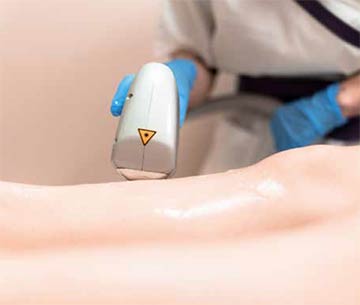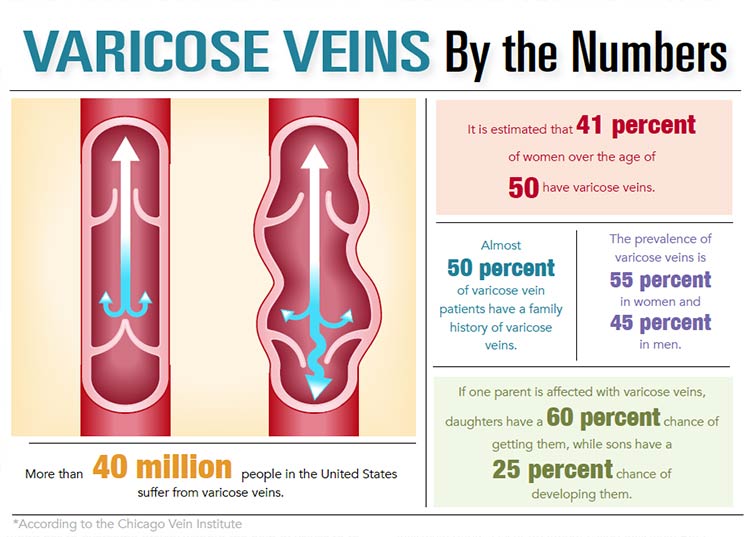Venous reflux disease, otherwise known as varicose veins, affects up to 35 percent of people in the United States, according to the Society of Vascular Surgery. Many women and men who deal with vascular vein issues hide their unsightly symptoms by wearing pants or by avoiding places like the beach or pool. Not only are varicose veins ugly, they also can cause a significant amount of pain, swelling and general discomfort. For people who are used to an active lifestyle, varicose veins can be quite debilitating.
Varicose veins are the result of a vein not functioning properly, causing it to become enlarged or overfilled with blood. Veins have one-way valves that act like rungs on a ladder. If they are malfunctioning, blood can’t get back to the heart efficiently. Similar to trying to climb a ladder with broken rungs, when these valves fail, the blood begins to collect in the veins and pressure builds up.
Varicose veins affect legs because not only are they far from the heart, but they also are below the heart most of the day. Blood has to overcome gravity without the help of valves to return to the heart. Pressure is greater the further your extremity is below the heart due to gravity, similar to the reason why your ears pop when you dive to the bottom of a pool. The further below the heart you go, the greater the pressure. This is why varicose veins and swelling usually occur first in the lower part of the leg.
Dr. Sean Hislop at the Coastal Vascular & Vein Center said that active people are at a higher risk of developing varicose veins.
“Two big risk factors are age and people who stand for long periods of time,” he said. “Over time, the cumulative effect of pressure caused by gravity causes you to develop varicose veins.”

Genetics also play a big role, along with being female and being pregnant or having had multiple pregnancies, which causes varicose veins for many reasons.
“Increased blood during pregnancy and the hormones associated with pregnancy cause veins to dilate,” Dr. Hislop explained. “Many pregnant women see the varicose veins go away after they have the baby, but, for some women, they do not go away or they come back later in life.”
Men suffer from varicose veins as well. In fact, a statistic from the website “Everyday Health” indicates that although one quarter of adult women suffer from visible varicose veins, about 10 to 15 percent of adult men deal with them, too. Dr. Joseph Mullaney with InvisiVein/Imaging Specialists in Mount Pleasant said that men tend to put off doing anything about it or they hide it longer than women.
“It seems like the women we see are mostly in their 30s and 40s, while the men tend to be older, in their 50s and 60s,” Dr. Mullaney said. “They seem to put up with it longer, until the symptoms become too much to bear.”
Even though being on your feet is a high risk factor, ironically, one of the best ways to treat varicose veins is with activity.
“Get up and exercise,” Dr. Hislop said. “Whatever you do, don’t become sedentary. That will cause them to become worse as being overweight is a risk factor and losing weight will help to keep the pressure down.”
He cited another way to battle the symptoms of varicose veins.
“Compression hose help to fight that pressure and force blood upward, rather than allowing it to pool,” he said.
Even though compression hose help the problem, once they are removed, the varicose veins are still there. The underlying cause has not been addressed, and that’s when more serious intervention is needed.
The days of stripping and removing the veins are over, according to Dr. Mullaney.
“There was less of a desired cosmetic outcome with that treatment, as well as increased pain and numbness and increased time to recover from the surgery,” he said.
InvisiVein offers a laser treatment called InvisiVein EVLT, which delivers a highly concentrated beam of light energy to the targeted vein tissue. The laser works with extreme precision to avoid the surrounding tissue. This procedure closes the incompetent vein, which redirects the blood to healthier veins.
“Only local anesthesia is needed, so patients resume their normal activity quickly,” Dr. Mullaney said. “Results are seen immediately, both cosmetically and symptomatically.”
Coastal Vascular & Vein Center offers two procedures to treat and close off the varicose veins, one involving heat and the other using a sealant. The non-surgical ClosureFast procedure utilizes radio frequencies to heat and contract the collagen found inside the vein walls. It then collapses the vein and shuts it off. VenaSeal, a fairly new technology for Coastal Vascular & Vein Center, uses adhesive to close the superficial vein. Dr. Hislop said that there is minimal discomfort with VenaSeal.
“It is the quickest recovery, as it only uses a single needle stick, so pain is minimal. No sedation is required for the procedure, no compression stockings are required post-operatively and there is a lower risk of other side effects, including nerve injury.”
Maria Long, a patient at Coastal Vascular & Vein Center, had the ClosureFast procedure on her legs nine years ago.
“Getting the procedure helped me feel so much better and made it look better, too,” she said. “The swelling went down, and I was able to get back to my usual workout and gardening activities. When I see women at the gym who are suffering with varicose veins, I tell them about my experience and that it is definitely worth getting treated by a vein specialist.”
Most insurance companies cover the InvisiVein laser treatment and the ClosureFast procedure but not VenaSeal. Both Dr. Hislop and Dr. Mullaney advise patients to check with their providers before seeking treatment. The InvisiVein website notes that treating varicose veins must be considered medically necessary, meaning there must be symptoms of pain, leg cramps, skin discoloration, ulcers or bleeding and that there must be presence of reflux on an ultrasound. Also, once the patient has exhibited those symptoms, there is a three-to-six-month trial period of treating the varicose veins with compression hose. If symptoms persist after the trial period, insurance will usually cover the procedure. Treating varicose or spider veins for cosmetic reasons alone will not be covered.
Dr. Mullaney noted that it is important to point out that varicose veins are different for everyone.
“Some people have it worse in one leg and some have equal pain in both,” he said. “Some people have abnormal veins that aren’t as visible but still cause significant pain, while others have visible veins that cause little pain and mostly just look bad. It really is different for everyone, but, if you notice them on your legs and are having symptoms, it is important to get them checked out by a vein specialist.”









